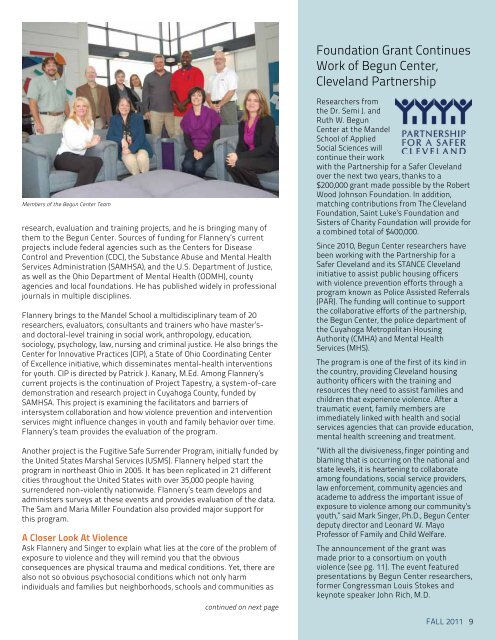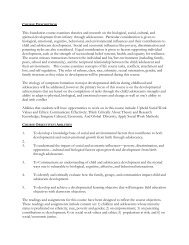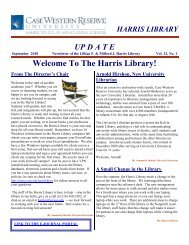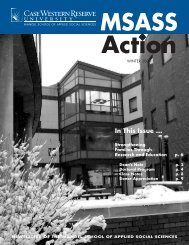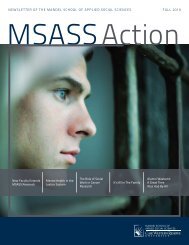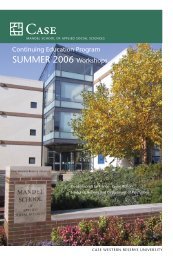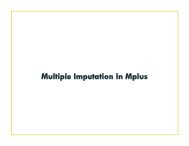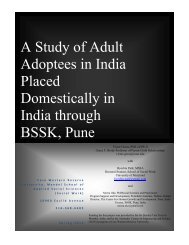Fall 2011 - Mandel School of Applied Social Sciences - Case ...
Fall 2011 - Mandel School of Applied Social Sciences - Case ...
Fall 2011 - Mandel School of Applied Social Sciences - Case ...
Create successful ePaper yourself
Turn your PDF publications into a flip-book with our unique Google optimized e-Paper software.
Foundation Grant Continues<br />
Work <strong>of</strong> Begun Center,<br />
Cleveland Partnership<br />
Members <strong>of</strong> the Begun Center Team<br />
research, evaluation and training projects, and he is bringing many <strong>of</strong><br />
them to the Begun Center. Sources <strong>of</strong> funding for Flannery’s current<br />
projects include federal agencies such as the Centers for Disease<br />
Control and Prevention (CDC), the Substance Abuse and Mental Health<br />
Services Administration (SAMHSA), and the U.S. Department <strong>of</strong> Justice,<br />
as well as the Ohio Department <strong>of</strong> Mental Health (ODMH), county<br />
agencies and local foundations. He has published widely in pr<strong>of</strong>essional<br />
journals in multiple disciplines.<br />
Flannery brings to the <strong>Mandel</strong> <strong>School</strong> a multidisciplinary team <strong>of</strong> 20<br />
researchers, evaluators, consultants and trainers who have master’sand<br />
doctoral-level training in social work, anthropology, education,<br />
sociology, psychology, law, nursing and criminal justice. He also brings the<br />
Center for Innovative Practices (CIP), a State <strong>of</strong> Ohio Coordinating Center<br />
<strong>of</strong> Excellence initiative, which disseminates mental-health interventions<br />
for youth. CIP is directed by Patrick J. Kanary, M.Ed. Among Flannery’s<br />
current projects is the continuation <strong>of</strong> Project Tapestry, a system-<strong>of</strong>-care<br />
demonstration and research project in Cuyahoga County, funded by<br />
SAMHSA. This project is examining the facilitators and barriers <strong>of</strong><br />
intersystem collaboration and how violence prevention and intervention<br />
services might influence changes in youth and family behavior over time.<br />
Flannery’s team provides the evaluation <strong>of</strong> the program.<br />
Another project is the Fugitive Safe Surrender Program, initially funded by<br />
the United States Marshal Services (USMS). Flannery helped start the<br />
program in northeast Ohio in 2005. It has been replicated in 21 different<br />
cities throughout the United States with over 35,000 people having<br />
surrendered non-violently nationwide. Flannery’s team develops and<br />
administers surveys at these events and provides evaluation <strong>of</strong> the data.<br />
The Sam and Maria Miller Foundation also provided major support for<br />
this program.<br />
A Closer Look At Violence<br />
Ask Flannery and Singer to explain what lies at the core <strong>of</strong> the problem <strong>of</strong><br />
exposure to violence and they will remind you that the obvious<br />
consequences are physical trauma and medical conditions. Yet, there are<br />
also not so obvious psychosocial conditions which not only harm<br />
individuals and families but neighborhoods, schools and communities as<br />
continued on next page<br />
Researchers from<br />
the Dr. Semi J. and<br />
Ruth W. Begun<br />
Center at the <strong>Mandel</strong><br />
<strong>School</strong> <strong>of</strong> <strong>Applied</strong><br />
<strong>Social</strong> <strong>Sciences</strong> will<br />
continue their work<br />
with the Partnership for a Safer Cleveland<br />
over the next two years, thanks to a<br />
$200,000 grant made possible by the Robert<br />
Wood Johnson Foundation. In addition,<br />
matching contributions from The Cleveland<br />
Foundation, Saint Luke’s Foundation and<br />
Sisters <strong>of</strong> Charity Foundation will provide for<br />
a combined total <strong>of</strong> $400,000.<br />
Since 2010, Begun Center researchers have<br />
been working with the Partnership for a<br />
Safer Cleveland and its STANCE Cleveland<br />
initiative to assist public housing <strong>of</strong>ficers<br />
with violence prevention efforts through a<br />
program known as Police Assisted Referrals<br />
(PAR). The funding will continue to support<br />
the collaborative efforts <strong>of</strong> the partnership,<br />
the Begun Center, the police department <strong>of</strong><br />
the Cuyahoga Metropolitan Housing<br />
Authority (CMHA) and Mental Health<br />
Services (MHS).<br />
The program is one <strong>of</strong> the first <strong>of</strong> its kind in<br />
the country, providing Cleveland housing<br />
authority <strong>of</strong>ficers with the training and<br />
resources they need to assist families and<br />
children that experience violence. After a<br />
traumatic event, family members are<br />
immediately linked with health and social<br />
services agencies that can provide education,<br />
mental health screening and treatment.<br />
“With all the divisiveness, finger pointing and<br />
blaming that is occurring on the national and<br />
state levels, it is heartening to collaborate<br />
among foundations, social service providers,<br />
law enforcement, community agencies and<br />
academe to address the important issue <strong>of</strong><br />
exposure to violence among our community’s<br />
youth,” said Mark Singer, Ph.D., Begun Center<br />
deputy director and Leonard W. Mayo<br />
Pr<strong>of</strong>essor <strong>of</strong> Family and Child Welfare.<br />
The announcement <strong>of</strong> the grant was<br />
made prior to a consortium on youth<br />
violence (see pg. 11). The event featured<br />
presentations by Begun Center researchers,<br />
former Congressman Louis Stokes and<br />
keynote speaker John Rich, M.D.<br />
FALL <strong>2011</strong> 9


